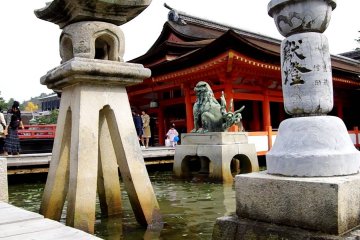
ศาลเจ้าอิซึตคุชิมะ มิยาจิม่า
Tomoko Kamishimaขั้นตอนอย่างเป็นทางในการบูชาของศาลเจ้า อิซึตคุชิมะคือ เดินทางเข้าสู่ศาลเจ้าบนเรือพิเศษ ผ่านประตูโทริสีแดงขนาดใหญ่

The Itsukushima Shrine is located on the shores of Miyajima, an island in the Seto Inland Sea not far from Hiroshima city. While the name Itsukushima means “island of worship”, the site is more famously known as “the floating shrine”, as the buildings appear to be floating on the water when the tide rolls in.
The 5-storied pagoda, on the shrine's northern side, is covered up and undergoing renovation works expected to last until December 20, 2026.
Itsukushima’s main shrine was first constructed in AD 593, and was mentioned in a famous Japanese book (Nihon Koki, or Notes on Japan) in AD 811. The shrine became popular as a pilgrimage destination for members of the Imperial Court during the Heian Period (745-1185) and remained an important location in the Edo Period for those living in western Japan.
The main shrine precinct consists of a collection of buildings, such as the Purification Hall and the stage for bugaku (court music) performances. Many of the buildings are linked by covered corridors and dotted with bronze lanterns from the early 20th century. An arched bridge, dating back to 1557, was said to be used by Imperial messengers and is one of the links between the shrine and the mainland. Most notably, Itsukushima is home to a Noh stage that dates back to the early Edo Period, and is significant for the fact that it’s the only Noh stage in the country that floats upon the sea.
Due to their history and unique design, the buildings of Itsukushima Shrine were designated as a National Treasure in 1952 and became a UNESCO World Heritage Site in 1996.
Visitors who wish to see the shrine as it “floats upon the waves” would do best to plan their visit according to the tides. A schedule of the day’s high and low tides is usually posted at the shrine’s main entrance.
Travel to JR Miyajimaguchi Station on the Sanyō Honsen Line. Walk to the ferry port. It's about 10 minutes from Miyajimaguchi Port to Miyajima Island by ferry.

ขั้นตอนอย่างเป็นทางในการบูชาของศาลเจ้า อิซึตคุชิมะคือ เดินทางเข้าสู่ศาลเจ้าบนเรือพิเศษ ผ่านประตูโทริสีแดงขนาดใหญ่

เกาะมิยาจิม่าในช่วงปลายเดือนพฤษจิกายน และสภาพอากาศก็ดีมาก
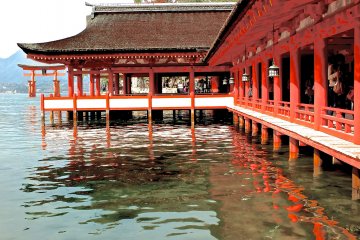
ศาลเจ้าอิซึตคุชิมะ ในช่วงน้ำขึ้น และวิวของประตูโทริอันโด่งดังไปทั่วโลก

เกาะมิยาจิม่ารู้จักกันว่าเป็นเกาะของเทพเจ้ามาเป็นเวลา 1400 ปี และเป็นเกาะที่ได้รับการสักการะบูชาของคนญี่ปุ่นทั่วประเทศ
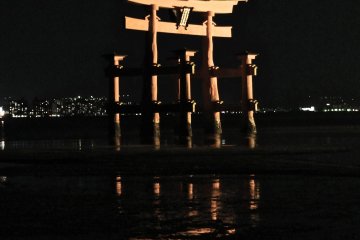
ค่ำคืนอันน่าพิศวงบนเกาะมิยาจิมะช่างแสนจะงดงาม ภาพถ่ายชุดนี้ถ่ายในช่วงปลายเดือนพฤศจิกายน
![ชมวิวดอกไม้ไฟที่มิยาจิมะ 2026 [ยกเลิกเรียบร้อย] ชมวิวดอกไม้ไฟที่มิยาจิมะ 2026 [ยกเลิกเรียบร้อย]](https://a2.cdn.japantravel.com/photo/6043-197209/360x240!/hiroshima-miyajima-fireworks-hiroshima-197209.jpg)
เทศกาลดอกไม้ไฟบนเกาะมิยาจิมะ เทศกาลดอกไม้ไฟที่มีชื่อเสียงที่สุดของฮิโจิมะ

ภายใต้ประตูโทริขนาดใหญ่ ที่ลอยอยู่กลางทะเลในเซะโตะ มีถนนแสงทองสะท้อนอยู่บนผืนน้ำ
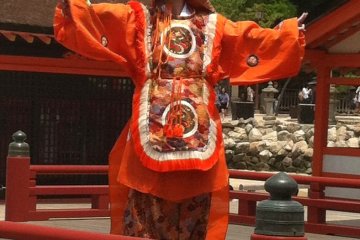
ศาลเจ้าอิซึตคุชิมะ (Itsukushima) จัดว่าเป็นหนึ่งในสถานที่อันงดงามที่สุดในญี่ปุ่น ส่วนบุกะกุ (bugaku) นั้นก็เป็นการฟ้อนรำพร้อมดนตรีแบบดั้งเดิมของญี่ปุ่น ที่มาเสริมให้สถานที่แห่งนี้มีมนต์ขลังยิ่งขึ้น
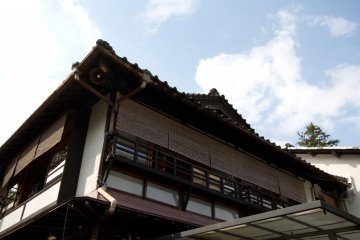
โรงแรมวะทะนะเบะ ในมิยะจิมะ เป็นโรงแรมที่สะดวกตั้งอยู่ตรงหน้าทางเข้าวัดไดโชะ บนถนนหลังที่เงียบสงบติดกับลำธาร

Hostel&CaféBar Backpackers Miyajima ซึ่งอยู่ห่างจากท่าเรือไปยังเกาะมิยาจิม่าเพียง 1 นาทีเท่านั้น แถมราคาถูกสุดๆ คือ อยู่ที่ 2,900 เยนต่อคน

ร้านฮายาชิ-ยะ ตั้งอยู่บนถนนหลังบ้านในย่านที่อยู่อาศัยที่มีมนต์เสน่ห์และมีชื่อเสียงมากที่สุดของฮิโรชิม่า ซึ่งก็คือ เกาะมิยาจิม่า นั่นเอง ร้านคาเฟ่เล็กๆแห่งนี้มีความเชี่ยวชาญในด้านการทำน้ำแข็งไส เซ็ทอาหารกลางวันและเครื่องดื่มที่มีคุณภาพชั้นยอด
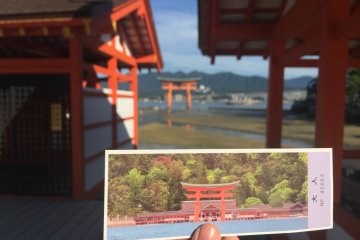
แต่ถ้าพูดถึงเรื่องอาหารท้องถิ่นที่เรืองชื่อของเกาะมิยาจิมะ ก็คงต้องยกให้ขนมหวานที่มีรสชาติและรูปร่าง "โมมิจิ" คำว่าโมมิจิแปลว่าใบเมเปิล

เทศกาลหอยนางรมบนเกาะมิยาจิมะ จัดให้มีขึ้นทุกปีในเดือนกุมภาพันธ์ ซึ่งเป็นช่วงฤดูหอยนางรม เทศกาลมีขึ้นในพื้นที่ติดกับท่าเรือ คุณสามารถลิ้มลองหอยนางรมหลากหลายชนิด จะเป็นหอยนางรมย่าง ทอด ในน้ำซุป และชุปแป้งทอด ในงานยังมีอาหารทะเลชนิดอึ่นๆ เช่น ปลาไหลทะเล (อะนะโกะ) และปลาทะเลต่างๆ ถ้าคุณไม่ต้องการยืนเข้าแถวนานๆ ควรวางแผนมาที่นี่แต่เช้าก่อนที่เทศกาลจะเริ่มขึ้น ในงานคุณจะได้เพลิดเพลินกับการแสดงทางวัฒนธรรมญี่ปุ่น การละเล่นด้วยขลุ่ยและกลองไทโกะในขณะที่นักแสดงเต้นรำและต่อสู้กันในชุดที่มีสีสรรสวยงาม นอกจากเข้าร่วมงานเทศกาลแล้ว คุณยังได้แวะชมสถานที่ที่มีชื่อเสียงของเกาะมิยาจิมะ

The Miyajima Omotesando Shopping Street is a 350m-long arcade that acts as one of the main paths between the island's port and Itsukushima Shrine. It's a lively thoroughfare filled with souvenir shops, street-side food counters as well as cafes, bars and restaurants. A folding roof provides a canopy to shelter from both rain or sun. Local delicacies steal the show so expect oysters, conger eel, momiji manju (a baked or deep-fried snack) or Miyajima craft beer along the route. Plenty of souvenir shops sell the famous shamoji (traditional wooden rice paddle) used for serving rice. A giant rice paddle—the symbolic Ōshakushi—used to be located here but has been relocated to the nearby etto Miyajima Community Centre. With most visitors to Miyajima not necessarily staying on the island overnight, many of the shops close by 5pm or 6pm. Nonetheless, once the sun sets the street takes on a warm, charming vibe under the glow of the lantern light that lines the street.

Momijidani Park (紅葉谷公園, Momijidani-Kōen) is one of the most famous maple leaves valley parks in Japan. The park is located at the foot of Mt. Misen, along Momijidani River, behind Itsukushima Shrine in Miyajima, Hiroshima. [Wikipedia]

Daishō-in or Daisyō-in is a historic Japanese temple complex with many temples and statues on Mount Misen, the holy mountain on the island of Itsukushima, off the coast of Hatsukaichi, Hiroshima, Japan. It is the 14th temple in the Chūgoku 33 Kannon Pilgrimage and famous for the maple trees and their autumn colors. [Wikipedia]